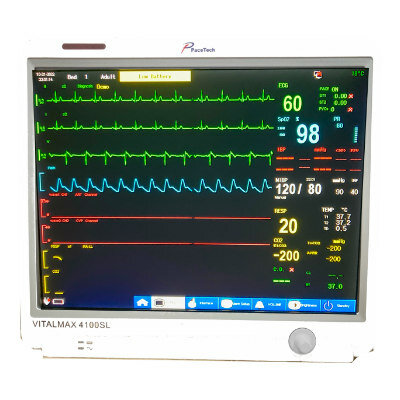China Healthcare Market to Reach USD 1 Trillion by 2020
|
By HospiMedica International staff writers Posted on 13 Nov 2017 |
China's healthcare market is projected to grow at a whopping CAGR of about 12% from USD 357 billion in 2011 to USD 1 trillion by 2020, driven by the country’s favorable demographic trends, continued urbanization, growing disease burden, economic expansion, and rising income levels providing access to treatments. These are the latest findings of McKinsey & Company (USA), a global management consulting firm.
According to McKinsey, China's healthcare market is shaped by three macrotrends, namely continued economic and demographic development, healthcare reforms, and the direction of the 12th five-year plan.
Continued economic and demographic development: The growth in demand for healthcare will be driven by the rapid proliferation of chronic conditions such as diabetes and hypertension due to China’s aging population, shift in population to the cities, and changes in lifestyle. The demand for healthcare will be further fueled by rising income levels and more extensive insurance coverage, thereby improving the ability of patients to pay for healthcare. Additionally, conditions such as cancer, depression, and respiratory illness are highly prevalent in China, and still remain underdiagnosed and undertreated. As a result, early and improved diagnosis, coupled with higher rates of treatment and compliance with therapies, will drive a significant increase in the number of patients and lead to an improvement in the clinical benefits of drugs.
Healthcare reforms: China’s healthcare reforms, which commenced in 2009, is expected to be completed by 2020, resulting in far-reaching transformation of the country’s healthcare system. The next stage of reform is expected to significantly impact the Chinese healthcare system, including extended insurance coverage and development of primary care infrastructure. The Chinese government’s insurance programs already cover more than 95 percent of the country’s population, and it will now focus on improving the quality of its provision to patients. The government also aims to develop a primary-care infrastructure, including community health centers and community health stations, along with a three-tier rural medical network comprised of county hospitals, township health centers, and village clinics. It will also focus on improving the service standards and quality of primary care institutions (primarily by educating and training general practitioners) and establishing a two-way referral system between primary-care facilities and hospitals.
Direction of the 12th five-year plan: In the 12th five-year plan published by the State Council in March 2011, the Chinese government has identified the biomedical industry among seven strategic industries. The biomedical industry includes biologics and small-molecule pharmaceuticals and vaccines, medical devices, diagnostics, and traditional Chinese medicine. The biomedical industry is poised for rapid growth over the coming decades, as the central government remains strongly committed to its development, with local governments expected to quickly follow suit.
All these factors will have positive implications for multinational companies, although increased government intervention, higher business complexity, and intensifying local competition will have negative implications. In order to succeed, multinationals will need to increase their investments across the value chain, step up their core capabilities, and explore how they can reach new customer segments in a more creative manner through partnerships.
Related Links:
McKinsey & Company
According to McKinsey, China's healthcare market is shaped by three macrotrends, namely continued economic and demographic development, healthcare reforms, and the direction of the 12th five-year plan.
Continued economic and demographic development: The growth in demand for healthcare will be driven by the rapid proliferation of chronic conditions such as diabetes and hypertension due to China’s aging population, shift in population to the cities, and changes in lifestyle. The demand for healthcare will be further fueled by rising income levels and more extensive insurance coverage, thereby improving the ability of patients to pay for healthcare. Additionally, conditions such as cancer, depression, and respiratory illness are highly prevalent in China, and still remain underdiagnosed and undertreated. As a result, early and improved diagnosis, coupled with higher rates of treatment and compliance with therapies, will drive a significant increase in the number of patients and lead to an improvement in the clinical benefits of drugs.
Healthcare reforms: China’s healthcare reforms, which commenced in 2009, is expected to be completed by 2020, resulting in far-reaching transformation of the country’s healthcare system. The next stage of reform is expected to significantly impact the Chinese healthcare system, including extended insurance coverage and development of primary care infrastructure. The Chinese government’s insurance programs already cover more than 95 percent of the country’s population, and it will now focus on improving the quality of its provision to patients. The government also aims to develop a primary-care infrastructure, including community health centers and community health stations, along with a three-tier rural medical network comprised of county hospitals, township health centers, and village clinics. It will also focus on improving the service standards and quality of primary care institutions (primarily by educating and training general practitioners) and establishing a two-way referral system between primary-care facilities and hospitals.
Direction of the 12th five-year plan: In the 12th five-year plan published by the State Council in March 2011, the Chinese government has identified the biomedical industry among seven strategic industries. The biomedical industry includes biologics and small-molecule pharmaceuticals and vaccines, medical devices, diagnostics, and traditional Chinese medicine. The biomedical industry is poised for rapid growth over the coming decades, as the central government remains strongly committed to its development, with local governments expected to quickly follow suit.
All these factors will have positive implications for multinational companies, although increased government intervention, higher business complexity, and intensifying local competition will have negative implications. In order to succeed, multinationals will need to increase their investments across the value chain, step up their core capabilities, and explore how they can reach new customer segments in a more creative manner through partnerships.
Related Links:
McKinsey & Company
Latest Business News
- Johnson & Johnson Acquires Cardiovascular Medical Device Company Shockwave Medical
- Mindray to Acquire Chinese Medical Device Company APT Medical
- Olympus Acquires Korean GI Stent Maker Taewoong Medical
- Karl Storz Acquires British AI Specialist Innersight Labs
- Stryker to Acquire French Joint Replacement Company SERF SAS
- Medical Illumination Acquires Surgical Lighting Specialist Isolux
- 5G Remote-Controlled Robots to Enable Even Cross-Border Surgeries

- International Hospital Federation Announces 2023 IHF Award Winners
- Unprecedented AI Integration Transforming Surgery Landscape, Say Experts

- New WHO Guidelines to Revolutionize AI in Healthcare
- Getinge Acquires US-Based Medical Equipment Provider Healthmark Industries
- Global Surgical Lights Market Driven by Increasing Number of Procedures
- Global Capsule Endoscopy Market Driven by Demand for Accurate Diagnosis of Gastrointestinal Conditions
- Global OR Integration Market Driven by Need for Improved Workflow Efficiency and Productivity
- Global Endoscopy Devices Market Driven by Increasing Adoption of Endoscopes in Surgical Procedures
- Global Minimally Invasive Medical Devices Market Driven by Benefits of MIS Procedures
Channels
Artificial Intelligence
view channel
AI-Powered Algorithm to Revolutionize Detection of Atrial Fibrillation
Atrial fibrillation (AFib), a condition characterized by an irregular and often rapid heart rate, is linked to increased risks of stroke and heart failure. This is because the irregular heartbeat in AFib... Read more
AI Diagnostic Tool Accurately Detects Valvular Disorders Often Missed by Doctors
Doctors generally use stethoscopes to listen for the characteristic lub-dub sounds made by heart valves opening and closing. They also listen for less prominent sounds that indicate problems with these valves.... Read moreCritical Care
view channel
Deep-Learning Model Predicts Arrhythmia 30 Minutes before Onset
Atrial fibrillation, the most common type of cardiac arrhythmia worldwide, affected approximately 59 million people in 2019. Characterized by an irregular and often rapid heart rate, atrial fibrillation... Read more
Breakthrough Technology Combines Detection and Treatment of Nerve-Related Disorders in Single Procedure
The peripheral nervous system (PNS) serves as the communication network that links the brain and spinal cord to every other part of the body. It consists of two parts: the somatic nervous system, which... Read moreSurgical Techniques
view channel
Hydrogel-Based Miniaturized Electric Generators to Power Biomedical Devices
The development of engineered devices that can harvest and convert the mechanical motion of the human body into electricity is essential for powering bioelectronic devices. This mechanoelectrical energy... Read moreWearable Technology Monitors and Analyzes Surgeons' Posture during Long Surgical Procedures
The physical strain associated with the static postures maintained by neurosurgeons during long operations can lead to fatigue and musculoskeletal problems. An objective assessment of surgical ergonomics... Read more.jpg)
Custom 3D-Printed Orthopedic Implants Transform Joint Replacement Surgery
The evolving field of 3D printing is revolutionizing orthopedics, especially for individuals requiring joint replacement surgeries where traditional implants fail to provide a solution. Although most people... Read more
Cutting-Edge Imaging Platform Detects Residual Breast Cancer Missed During Lumpectomy Surgery
Breast cancer is becoming increasingly common, with statistics indicating that 1 in 8 women will develop the disease in their lifetime. Lumpectomy remains the predominant surgical intervention for treating... Read morePatient Care
view channel
Surgical Capacity Optimization Solution Helps Hospitals Boost OR Utilization
An innovative solution has the capability to transform surgical capacity utilization by targeting the root cause of surgical block time inefficiencies. Fujitsu Limited’s (Tokyo, Japan) Surgical Capacity... Read more
Game-Changing Innovation in Surgical Instrument Sterilization Significantly Improves OR Throughput
A groundbreaking innovation enables hospitals to significantly improve instrument processing time and throughput in operating rooms (ORs) and sterile processing departments. Turbett Surgical, Inc.... Read more
Next Gen ICU Bed to Help Address Complex Critical Care Needs
As the critical care environment becomes increasingly demanding and complex due to evolving hospital needs, there is a pressing requirement for innovations that can facilitate patient recovery.... Read moreGroundbreaking AI-Powered UV-C Disinfection Technology Redefines Infection Control Landscape
Healthcare-associated infection (HCAI) is a widespread complication in healthcare management, posing a significant health risk due to its potential to increase patient morbidity and mortality, prolong... Read moreHealth IT
view channel
Machine Learning Model Improves Mortality Risk Prediction for Cardiac Surgery Patients
Machine learning algorithms have been deployed to create predictive models in various medical fields, with some demonstrating improved outcomes compared to their standard-of-care counterparts.... Read more
Strategic Collaboration to Develop and Integrate Generative AI into Healthcare
Top industry experts have underscored the immediate requirement for healthcare systems and hospitals to respond to severe cost and margin pressures. Close to half of U.S. hospitals ended 2022 in the red... Read more
AI-Enabled Operating Rooms Solution Helps Hospitals Maximize Utilization and Unlock Capacity
For healthcare organizations, optimizing operating room (OR) utilization during prime time hours is a complex challenge. Surgeons and clinics face difficulties in finding available slots for booking cases,... Read more
AI Predicts Pancreatic Cancer Three Years before Diagnosis from Patients’ Medical Records
Screening for common cancers like breast, cervix, and prostate cancer relies on relatively simple and highly effective techniques, such as mammograms, Pap smears, and blood tests. These methods have revolutionized... Read morePoint of Care
view channel
Critical Bleeding Management System to Help Hospitals Further Standardize Viscoelastic Testing
Surgical procedures are often accompanied by significant blood loss and the subsequent high likelihood of the need for allogeneic blood transfusions. These transfusions, while critical, are linked to various... Read more
Point of Care HIV Test Enables Early Infection Diagnosis for Infants
Early diagnosis and initiation of treatment are crucial for the survival of infants infected with HIV (human immunodeficiency virus). Without treatment, approximately 50% of infants who acquire HIV during... Read more
Whole Blood Rapid Test Aids Assessment of Concussion at Patient's Bedside
In the United States annually, approximately five million individuals seek emergency department care for traumatic brain injuries (TBIs), yet over half of those suspecting a concussion may never get it checked.... Read more















